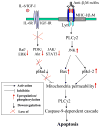Killing tumor cells through their surface beta(2)-microglobulin or major histocompatibility complex class I molecules
- PMID: 20143445
- PMCID: PMC2847067
- DOI: 10.1002/cncr.24953
Killing tumor cells through their surface beta(2)-microglobulin or major histocompatibility complex class I molecules
Abstract
Targeted antibody-based therapy has been used successfully to treat cancers. Recent studies have demonstrated that tumor cells treated with antibodies specific for beta(2)-microglobulin (beta(2)M) or major histocompatibility complex (MHC) class I molecules undergo apoptosis in vitro and in vivo (mouse models). Antibodies against beta(2)M or MHC class I induce tumor cell apoptosis by 1) recruiting MHC class I molecules to lipid rafts and activating LYN kinase and the signal-transducing enzyme phospholipase C-gamma2-dependent c-Jun N-terminal kinase signaling pathway and 2) expelling interleukin 6 and insulin-like growth factor 1 receptors out of lipid rafts and inhibiting the growth and survival factor-induced activation of the phosphatidylinositol 3-kinase/Akt and extracellular signal-related kinase pathways. Consequently, mitochondrial integrity is compromised, and the caspase-9-dependent cascade is activated in treated tumor cells. However, although beta(2)M and MHC class I are expressed on normal hematopoietic cells, which is a potential safety concern, the monoclonal antibodies were selective to tumor cells and did not damage normal cells in vitro or in human-like mouse models. These findings suggest that targeting beta(2)M or MHC class I by using antibodies or other agents offers a potential therapeutic approach for beta(2)M/MHC class I-expressing malignancies. Cancer 2010. (c) 2010 American Cancer Society.
Conflict of interest statement
Conflict of Interest Disclosures
Figures
Similar articles
-
Anti beta2-microglobulin monoclonal antibodies induce apoptosis in myeloma cells by recruiting MHC class I to and excluding growth and survival cytokine receptors from lipid rafts.Blood. 2007 Oct 15;110(8):3028-35. doi: 10.1182/blood-2007-06-094417. Epub 2007 Jul 20. Blood. 2007. PMID: 17644731 Free PMC article.
-
Targeting beta2-microglobulin for induction of tumor apoptosis in human hematological malignancies.Cancer Cell. 2006 Oct;10(4):295-307. doi: 10.1016/j.ccr.2006.08.025. Cancer Cell. 2006. PMID: 17045207
-
Targeting cell surface β2 -microglobulin by pentameric IgM antibodies.Br J Haematol. 2011 Jul;154(1):111-21. doi: 10.1111/j.1365-2141.2011.08714.x. Epub 2011 May 9. Br J Haematol. 2011. PMID: 21554263 Free PMC article.
-
β2-Microglobulin-mediated signaling as a target for cancer therapy.Anticancer Agents Med Chem. 2014 Mar;14(3):343-52. doi: 10.2174/18715206113139990092. Anticancer Agents Med Chem. 2014. PMID: 23848204 Free PMC article. Review.
-
Signal transduction by the major histocompatibility complex class I molecule.APMIS. 1999 Oct;107(10):887-95. doi: 10.1111/j.1699-0463.1999.tb01488.x. APMIS. 1999. PMID: 10549585 Review.
Cited by
-
Molecular and translational biology of the blood-based VeriStrat® proteomic test used in cancer immunotherapy treatment guidance.J Mass Spectrom Adv Clin Lab. 2023 Nov 20;30:51-60. doi: 10.1016/j.jmsacl.2023.11.001. eCollection 2023 Nov. J Mass Spectrom Adv Clin Lab. 2023. PMID: 38074293 Free PMC article.
-
Supernatants from lymphocytes stimulated with Bacillus Calmette-Guerin can modify the antigenicity of tumours and stimulate allogeneic T-cell responses.Br J Cancer. 2011 Aug 23;105(5):687-93. doi: 10.1038/bjc.2011.306. Epub 2011 Aug 9. Br J Cancer. 2011. PMID: 21829193 Free PMC article.
-
Promotion on NLRC5 upregulating MHC-I expression by IFN-γ in MHC-I-deficient breast cancer cells.Immunol Res. 2019 Dec;67(6):497-504. doi: 10.1007/s12026-019-09111-w. Immunol Res. 2019. PMID: 31900803
-
Tumor necrosis factor α-induced hypoxia-inducible factor 1α-β-catenin axis regulates major histocompatibility complex class I gene activation through chromatin remodeling.Mol Cell Biol. 2013 Jul;33(14):2718-31. doi: 10.1128/MCB.01254-12. Epub 2013 May 13. Mol Cell Biol. 2013. PMID: 23671189 Free PMC article.
-
Proteomic Analysis Reveals a Novel Therapeutic Strategy Using Fludarabine for Steroid-Resistant Asthma Exacerbation.Front Immunol. 2022 Feb 25;13:805558. doi: 10.3389/fimmu.2022.805558. eCollection 2022. Front Immunol. 2022. PMID: 35280986 Free PMC article.
References
-
- Yewdell JW, Reits E, Neefjes J. Making sense of mass destruction: quantitating MHC class I antigen presentation. Nat Rev Immunol. 2003;3:952–961. - PubMed
-
- Buus S. MHC restricted antigen presentation and T cell recognition. Dan Med Bull. 1994;41:345–358. - PubMed
-
- Bjorkman PJ, Burmeister WP. Structures of two classes of MHC molecules elucidated: crucial differences and similarities. Curr Opin Struct Biol. 1994;4:852–856. - PubMed
-
- Strominger JL. Human histocompatibility proteins. Immunol Rev. 2002;185:69–77. - PubMed
-
- Natarajan K, Li H, Mariuzza RA, et al. MHC class I molecules, structure and function. Rev Immunogenet. 1999;1:32–146. - PubMed
Publication types
MeSH terms
Substances
Grants and funding
LinkOut - more resources
Full Text Sources
Other Literature Sources
Research Materials
Miscellaneous


